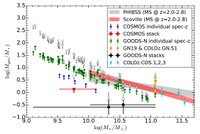The Dense Gas History of the Universe
 The authors describe the CO Luminosity Density at High-z (COLDz) survey, the first spectral line deep field targeting CO(1–0) emission from galaxies at z = 1.95 – 2.85 and CO(2–1) at z = 4.91–6.70. The main goal of COLDz is to constrain the cosmic density of molecular gas at the peak epoch of cosmic star formation. By targeting both a wide (~51 arcmin2) and a deep (~9 arcmin2) area, the survey is designed to robustly constrain the bright end and the characteristic luminosity of the CO(1–0) luminosity function. An extensive analysis of the reliability of the survey’s line candidates and new techniques provides detailed completeness and statistical corrections as necessary to determine the best constraints to date on the CO luminosity function. The blind search for CO(1–0) uniformly selects starbursts and massive main-sequence galaxies based on their cold molecular gas masses. The search also detects CO(2–1) line emission from optically dark, dusty star-forming galaxies at z > 5. Pavesi et al. find a range of spatial sizes for the CO-traced gas reservoirs up to ~40 kiloparsecs, suggesting that spatially extended cold molecular gas reservoirs may be common in massive, gas-rich galaxies at z ~ 2. Through CO line stacking, they constrain the gas mass fraction in previously known typical star-forming galaxies at z = 2 – 3. The stacked CO detection suggests lower molecular gas mass fractions than expected for massive main-sequence galaxies by a factor of ~3–6. The authors find total CO line brightness at ~34 GHz of 0.45 ± 0.2 μK, which constrains future line intensity mapping and Cosmic Microwave Background experiments.
The authors describe the CO Luminosity Density at High-z (COLDz) survey, the first spectral line deep field targeting CO(1–0) emission from galaxies at z = 1.95 – 2.85 and CO(2–1) at z = 4.91–6.70. The main goal of COLDz is to constrain the cosmic density of molecular gas at the peak epoch of cosmic star formation. By targeting both a wide (~51 arcmin2) and a deep (~9 arcmin2) area, the survey is designed to robustly constrain the bright end and the characteristic luminosity of the CO(1–0) luminosity function. An extensive analysis of the reliability of the survey’s line candidates and new techniques provides detailed completeness and statistical corrections as necessary to determine the best constraints to date on the CO luminosity function. The blind search for CO(1–0) uniformly selects starbursts and massive main-sequence galaxies based on their cold molecular gas masses. The search also detects CO(2–1) line emission from optically dark, dusty star-forming galaxies at z > 5. Pavesi et al. find a range of spatial sizes for the CO-traced gas reservoirs up to ~40 kiloparsecs, suggesting that spatially extended cold molecular gas reservoirs may be common in massive, gas-rich galaxies at z ~ 2. Through CO line stacking, they constrain the gas mass fraction in previously known typical star-forming galaxies at z = 2 – 3. The stacked CO detection suggests lower molecular gas mass fractions than expected for massive main-sequence galaxies by a factor of ~3–6. The authors find total CO line brightness at ~34 GHz of 0.45 ± 0.2 μK, which constrains future line intensity mapping and Cosmic Microwave Background experiments.
Image: The molecular gas mass fraction constraints for galaxies with spectroscopic redshifts for which the CO(1–0) emission can be constrained by the COLDz data. The color points assume αCO = 3.6M⊙ (K km s−1 pc2)−1; the gray points correspond to adopting the metallicity-dependent αCO from Genzel et al. (2015). Upper limits are 3σ and assume a line FWHM of 300 km/sec. The gray and red shaded regions correspond to the reported average expected gas mass fraction in the range z ∼ 2.0–2.8 for main-sequence galaxies.
Publication: Riccardo Pavesi (Cornell University) et al., The CO Luminosity Density at High-z (COLDz) Survey: A Sensitive, Large-area Blind Search for Low-J CO Emission from Cold Gas in the Early Universe with the Karl G. Jansky Very Large Array, Astrophysical Journal, 864, 49 (1 September 2018).




Connect with NRAO